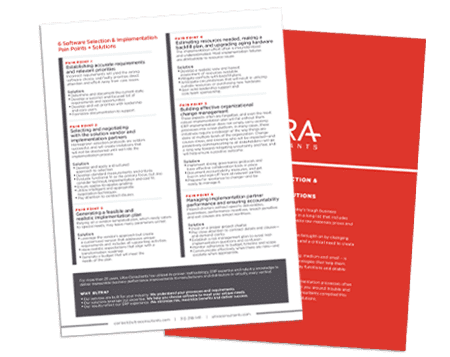Chances are if you are one of the thousands of companies that will be looking at a new ERP this year, you are updating from a 10-year-old system or you are moving to your first major system.
Either way, you will be dazzled with all the new things that you can get from a new ERP system.
The reporting, dashboards, interface, and graphics will all be flashy and capture your attention. You may find yourself so excited that you want to move immediately to upgrading with the first software vendor you see.

More than Technology
Don’t make the mistake of quickly jumping into software demos, nor should you just view a single demo.
All of today’s modern systems will dazzle you and seem like a large improvement, but not all systems are the right fit for your business.
ERP systems are rapidly improving, they all have their own strengths and weaknesses.
The features you find most impressive may actually be common among most systems and you are missing the critical parts of your business. Remember, productivity is not about the “look” of a software system, it is about automation, information, and number of screens/clicks.
While it’s tempting to consider these initiatives as pure “technology or IT projects,” that perspective is not effective and often results in an implementation that fails to meet expectations. IT may lead the project and certainly has a major role, but ERP projects touch almost every area of the business. The new system will naturally bring some change to how business is done, so it’s important that business process owners are heavily involved.
Decision Drivers
Instead of being impressed with the latest user interface, Ultra’s ERP selection consultant team suggests our clients work with a set of software decision drivers which will vary for every organization depending on what is the best match for the specific functional areas of the business. Those drivers include:
1 – Features and Functionality
Does the software meet the future state needs of the business? Will users find the software intuitive and easy-to-use? Does the software have advanced industry functionality to support dynamic business needs?
2 – Vendor Synergy
Does the vendor understand the specifics of the business? Is the vendor aligned with the specific requirements of the organization?
3 – Solution Agility and Viability
Is the vendor invested in this product solution? Will the software be a part of its service offering for the long-term?
4 – Technology Alignment
Does the platform fit within the team’s technology roadmap? Is the vendor following industry standards for current and future integrations?
5 – Total Cost of Ownership
Are licensing fees, maintenance and subscription costs understood? Are fees for services/support and integrations included?
6 – Implementation Considerations
Does the vendor’s implementation methodology align with the organization? Is the project plan comprehensive with adequate detail? How are risks and issues managed?
A Better Way Forward
Transforming your business processes, with an ERP system as a technology enabler, requires creating a vision of the future state from the current state – and then on to defining the business value for the project.
Done properly, this foundation will establish alignment of expectations with management, improve the efficiency of the project team, eliminate process waste, and reduce the time to benefit for the project.
Thus, when a project team is considering an ERP selection project, it’s imperative that the selection process is based on a solid foundation of industry expertise, vendor research and intimate knowledge of the business, all aligned with the goal of improved business performance.
So in a nutshell, we suggest this strategy: Know your users, know your business, understand your current state.
Then look at best practices to incorporate into your future state requirements. Finally, find the right solution that matches strengths to your needs.
About the Author
Matthew Hull has more than 15 years of experience transforming businesses utilizing Lean methodology and effective use of technology. With successful tenure as both the user and as a 3rd party support in ERP Implementation, Process Improvement, S&OP, Matthew has deep professional experience as an Operations Manager, Business Transformation, Leader Global Supply Chain Manager, Lean Six Sigma Manager. Matthew holds a BS in Industrial Technology and Engineering from Ohio University; an MBA from Eli Broad College of Business – Michigan State University; Lean Six Sigma Black Belt Certifications from University of Michigan, The George’s Group, and Black & Decker. He brings domain expertise in the areas of Automotive, Medical Devices & Products, Distribution, Industrial Equipment, Consumer Goods, Metal Fabrication, Electronics, Oil & Gas, including experience in internal and external consulting for Fortune 500 Company.

6 Software Selection & Implementation Pain Points + Solutions
Software selection and implementation processes often present challenges of their own. To steer you around trouble and help you drive success, Ultra’s experts compiled a list of pain points and solutions to be aware of as you embark on this journey.
Table of Contents
More ERP material...
AI in Food and Beverage Manufacturing
Discover how AI is revolutionizing food and beverage manufacturing, enhancing quality, reducing…
How ERP for Quality Control Eliminates Manual Documentation Chaos
This post will examine why managing quality records outside of an ERP…
Assessing Your AI Maturity
This article breaks down how businesses can measure their AI maturity to…



